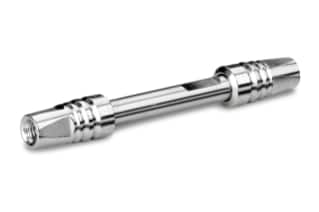
|
Chemistry |
C18 |
|
Separation Mode |
Reversed Phase |
|
Particle Substrate |
Silica |
|
pH Range Min |
1 pH |
|
pH Range Max |
8 pH |
|
Temperature Limits |
45 C |
|
Maximum Pressure |
18000 psi (1240 Bar) |
|
Endcapped |
Yes |
|
Silanol Activity |
Low |
|
Particle Shape |
Spherical |
|
Particle Size |
1.8 µm |
|
Endfitting Type |
Parker-style |
|
Pore Size |
100 Å |
|
Format |
Column |
|
Surface Area |
230 |
|
System |
UHPLC, UPLC |
|
Particle Technology |
HSS |
|
USP Classification |
L1 |
|
Inner Diameter |
2.1 mm |
|
Length |
50 mm |
|
Carbon Load |
15 % |
|
eCord |
Yes |
|
UNSPSC |
41115709 |
|
Brand |
ACQUITY UPLC |
|
Product Type |
Columns |
|
Units per Package |
1 pk |
ACQUITY UPLC HSS C18 Column, 100Å, 1.8 µm, 2.1 mm X 50 mm, 1/pk
Born from an innovative synthetic process, Waters’ High Strength Silica (HSS) particle technology increases the mechanical stability of silica while maintaining pore volumes similar to those in HPLC silica-based materials. This novel particle technology provides increased retentivity when compared to hybrid particles while serving as the ideal substrate to create stationary phases with alternate selectivity that can withstand UPLC pressures. The ACQUITY UPLC HSS C18 Column offers high mechanical stability and the appropriate morphology to provide long column lifetimes and UPLC efficiencies at pressures up to 15,000 psi (1000 bar). The 1.8 µm UPLC HSS particle is designed and tested specifically for use in UPLC separations.
The ACQUITY UPLC HSS C18 chemistry is a full end-capped, high coverage, ultra-performance C18 bonded phase which provides peak shape for bases, along with increased retention when compared to lab equipment like the ACQUITY UPLC BEH C18 Column. The stationary phase features a trifunctionally bonded C18 ligand in addition to a proprietary process for end-capping that yields superior peak shapes for bases at neutral pH, while also resisting acidic hydrolysis, allowing for extremely long lifetimes at low pH.
ACQUITY HSS packing materials are designed to be used with the ACQUITY UPLC system and related products like the ACQUITY UPLC HSS C18 VanGuard Pre-column, 100Å, 1.8 µm, 2.1 mm X 5 mm, 3/pk and will offer the best performance when used in this family. Each column is individually tested and includes a Performance Chromatogram and a Certificate of Batch analysis. Each batch of ACQUITY HSS material is also tested chromatographically with acidic, basic, and neutral analytes, with results held to narrow specification ranges.
Where Can I Get Column Use Information?
Each ACQUITY UPLC HSS C18 Column comes with an eCord chip that provides column use data. When used, the software will display identifiers of the column such as chemistry type, column dimensions, and serial number. Overall column usage information will include the total number of samples, total number of injections, total sample sets, date of first injection and last injection, maximum pressure, and temperature. This information will also detail the column history by sample set, including the date started, sample set name, user name, system name, number of injections and samples in the sample set, maximum pressure, and temperature.